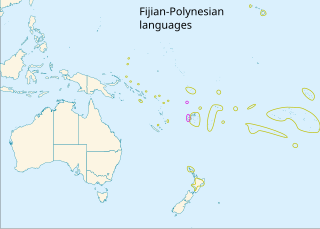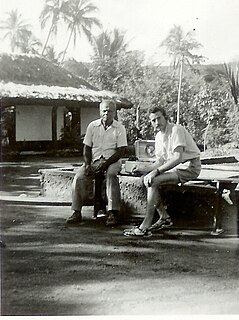Related Research Articles

Melanesia is a subregion of Oceania in the southwestern Pacific Ocean. It extends from the island of New Guinea in the west to Tonga in the east, and includes the Arafura Sea.

The Polynesian languages form a language family spoken in geographical Polynesia and on a patchwork of outliers from south central Micronesia to small islands off the northeast of the larger islands of the southeast Solomon Islands and sprinkled through Vanuatu. Linguistic taxonomists classify them as a subgroup of the much larger and more varied Austronesian family, belonging to the Oceanic branch of that family. Polynesians share many unique cultural traits that resulted from only about 1000 years of common development, including common linguistic development, in the Tonga and Samoa area through most of the first millennium BC.

The Papuan languages are the non-Austronesian and non-Australian languages spoken on the western Pacific island of New Guinea, and neighbouring islands, by around 4 million people. It is a strictly geographical grouping, and does not imply a genetic relationship. The concept of Papuan peoples as distinct from Austronesian-speaking Melanesians was first suggested and named by Sidney Herbert Ray in 1892.

The approximately 450 Oceanic languages are a branch of the Austronesian languages. The area occupied by speakers of these languages includes Polynesia, as well as much of Melanesia and Micronesia. Though covering a vast area, Oceanic languages are spoken by only two million people. The largest individual Oceanic languages are Eastern Fijian with over 600,000 speakers, and Samoan with an estimated 400,000 speakers. The Gilbertese (Kiribati), Tongan, Tahitian, Māori, Western Fijian and Tolai languages each have over 100,000 speakers. The common ancestor which is reconstructed for this group of languages is called Proto-Oceanic.

The Southern Oceanic languages are a linkage of Oceanic languages spoken in Vanuatu and New Caledonia. It was proposed by Lynch, Ross, and Crowley in 2002 and supported by later studies. They consider it to be a linkage rather than a language group with a clearly defined internal nested structure.
Malcolm David Ross is an Australian linguist. He is the emeritus professor of linguistics at the Australian National University.
Andrew Kenneth Pawley, FRSNZ, FAHA, is Emeritus Professor at the School of Culture, History & Language of the College of Asia & the Pacific at the Australian National University. Pawley was born in Sydney but moved to New Zealand at the age of 12.
Proto-Oceanic is a proto-language that historical linguists since Otto Dempwolff have reconstructed as the hypothetical common ancestor of the Oceanic subgroup of the Austronesian language family. Proto-Oceanic is a descendant of the Proto-Austronesian language (PAN), the common ancestor of the Austronesian languages.
Ward Hunt Goodenough II was an American anthropologist, who has made contributions to kinship studies, linguistic anthropology, cross-cultural studies, and cognitive anthropology.

George William Grace was an emeritus professor of linguistics at the University of Hawaiʻi. He specialized in historical and comparative linguistics, ethnolinguistics, and Austronesian languages, especially the Oceanic languages of Melanesia. He joined the Department of Linguistics in 1964, serving three years as chair (1966–1969) and three decades as editor of Oceanic Linguistics (1962–1991), a journal he founded while teaching anthropology at Southern Illinois University (1960–1964).
Apalɨ (Apal), or Emerum, is a Papuan language of Madang Province, Papua New Guinea. Akɨ and Acɨ are two dialects that are quite different from each other.
The Taulil–Butam or Butam–Taulil languages are a small language family spoken in East New Britain Province, Papua New Guinea. They may be related to the Baining languages. Speakers consistently report that their ancestors came from New Ireland.
Moiso is an Espiritu Santo language of Vanuatu. It is spoken in Moriuli village in central Santo Island by about 100 people.
Kene is an Espiritu Santo language of Vanuatu with 300 speakers.
Daruru is an Espiritu Santo language of Vanuatu. There are perhaps 100 speakers in Pelmol village of western Santo Island.
Retlatur is an Espiritu Santo language of Vanuatu. There are about 100 speakers in Tanovusivusi village of southern Santo Island.
Atin is an Espiritu Santo language of Vanuatu. There are 120 speakers in Nambauk (Patunfarambu) and Fumatal villages of eastern Santo Island.
Farnanto is an Espiritu Santo language of Vanuatu. There are about 100 speakers in Nambauk, Tanmet, and Tafua villages of eastern Santo Island.
Fanafo is an Espiritu Santo language of Vanuatu. It is spoken by 20 people in Vanafo and Butmas villages of eastern Santo Island.
Bura is an Espiritu Santo language of Vanuatu with 300 speakers.
References
- 1 2 3 4 Pawley, Andrew (2016). "In Memoriam, Ann Chowning, 1929-2016". Oceanic Linguistics. 55 (2): 678–685. doi:10.1353/ol.2016.0030. JSTOR 26408433. S2CID 151312270 . Retrieved 2021-01-03.
- 1 2 3 Huntsman, Judith (2005). "Ann Chowning - Polymath Anthropologist and Traveller". pp. ix–xvi. hdl:2292/4530 . Retrieved 2021-01-03.
- ↑ Gross, Claudia, Lyons, Harriet D., and Counts, Dorothy (2005). "A Polymath Anthropologist: Essays in Honour of Ann Chowning". Research in anthropology and linguistics 6. Dept. of Anthropology, University of Auckland. hdl:2292/4530 . Retrieved 2021-01-03.CS1 maint: multiple names: authors list (link)
- ↑ "Memorial service for Prof Ann Chowning". Association of Social Anthropologists of Aotearoa New Zealand. Retrieved 2021-01-03.
- ↑ "The Louisiana Iris Suite - The Arkansas Hybridizers". www.victoria-adventure.org. Retrieved 2021-01-03.